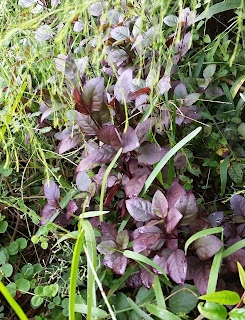Common Names: Tall boneset , Tall
thoroughwort
Latin Names: Eupatorium altissimum
Common Names: White boneset, Late
boneset, Late-flowering boneset, Lateflowering thoroughwort
Latin Names: Eupatorium serotinum
Common Names: Pine barren thoroughwort
– Probably not this one since it is very rare.
Latin Names: Eupatorium resinosum
Type: Herbaceous
Origin: Native
Description: The plant grows up to 6’
(depending on species). It branches off near the top of the plant. Leaves are small
and opposite. Flowers are small and white and form in a cluster.
Edible: No. Poisonous to humans and livestock.
Other uses: There are references to
using this to help with gout but it can cause liver damage or death. Attracts
bees.
Notes: In the wet field in back and
are 2-3’ tall. Blooms September. Haven’t figured out the species yet. From
online: “Comments: The delicate flowers of Late Boneset closely
resemble the flowers of other Bonesets, such as Eupatorium
altissimum (Tall Boneset) and Eupatorium
perfoliatum (Common Boneset), in both color and
structure. These Bonesets can be distinguished readily from each other by an
examination and comparison of their leaves. Tall Boneset has leaves that are
pubescent, more narrow, and less coarsely serrated than Late Boneset, while
Common Boneset has leaves that wrap around the stem and are without petioles.”

 |
| Boneset (September) |
 |
Boneset (September)
|
 |
Boneset (September)
|




















